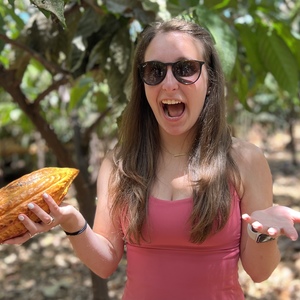What ensues when the dining staff at Crossroads dining center, “Croads”, places those perfectly chewy, remarkably round, positively delectable chocolate cookies on the dessert counter? Absolute pandemonium. Worn down from the stress of Berkeley’s never-ending midterm season and likely on the brink of starvation from back-to-back classes, students flock to these chocolate chip cookies as if they were the last ones on earth. Of course, once students make it to the front of the cookie line, they can’t just take one, or two, or even three cookies back with them. No, Berkeley students come prepared to maximize their cookie consumption before Croads runs out. They join the line carrying napkins, bowls, plastic bags—anything that allows them to leave with no less than a 5-inch stack of those chocolatey slices of heaven. But what makes them so good? Is it possible to crack the CalDining cookie recipe?
What are Vegan Cookies Made out of?

Vegan foods cannot contain meat or animal byproducts. This means that vegan cookies can’t contain common ingredients such as eggs, milk, and butter. So what do these recipes use instead? To truly comprehend the substitutes used in vegan recipes, we have to understand what the original ingredient’s role in the cookie is.
Butter: Butter is primarily used for its fat content, and gives cookies their rich flavor while also contributing to the softness and structure. The most common substitutes for butter include sunflower, coconut, or vegetable oil. The biggest factor in selecting an oil to include depends on its contribution to the cookie’s overall taste. Oils derived from plants with stronger flavors (such as coconut oil) may end up infusing this natural flavor into the cookie, affecting its taste.
Milk: While the oils contribute the fat and “buttery” flavor to the cookie, they lack milk—the active ingredient in butter that contributes to the cookie’s structure. Thus, vegan cookie recipes include plant-based milks to make up for this deficit.
Eggs: The role of eggs in cookie recipes has nothing to do with flavor and everything to do with binding ingredients together and providing a good rise when baking. Substitutes include xanthan gum, applesauce, and mashed banana. Similar to oil, using a substitute with a strong natural flavor runs the risk of that flavor being added to the cookie.
Chocolate: Finally, the chocolate itself must be vegan. Thus just means that the chocolate can’t contain milk. Many brands such as Lindt, Ghirardelli, and Trader Joe’s, make milk-free chocolate, so vegan chocolate isn’t too hard to find.
Now that we’ve explored our options, what ingredients does Crossroads use to make their cookies so delicious?
Cracking the Croads Recipe

The Basics:
Unsurprisingly, the Croads chocolate chip cookies contain all your typical cookie ingredients: salt, vanilla, baking soda, flour, and sugar. CalDining also employs vegan chocolate chips in their recipe, since milk chocolate isn’t vegan.
Butter Substitute: CalDining uses rice dextrin, “sustainable RSPO”, and palm oil shortening as butter substitutes. Rice dextrin is incredibly common, and can be found in any grain based item at the supermarket. Dextrins are complex fibers derived from various kinds of starch. They are often used as thickening agents or fat substitutes. “RSPO” stands for “Roundtable on Sustainable Palm Oil”, a company committed to ethically farming and producing palm oil. Extracted from palm fruit seeds, palm oil is a widely used vegetable oil that can be processed to create palm oil shortening. Palm oil products are noteworthy for their ability to remain solid at room temperature, so its inclusion in the recipe makes sense given the cookies must make it through the entire dinner service without melting. All three products are colorless and odorless. Considering their vegan cookies taste no different from non-vegan chocolate chip cookies, the choice of dextrin and palm oil in CalDining’s recipe is critical to avoiding the introduction of any additional flavors.
Egg Substitute: Another listed ingredient is vegan molasses. Molasses’ thick, sticky structure makes it a great binding agent in sweets and therefore can be used to replace egg in vegan products. Most molasses producers also produce various kinds of sugar products that use bone char, an animal by-product, in order to achieve a whitish-clear color in their sugar products. Thus, vegan molasses specifies that the molasses is produced in a facility that does not use bone char.
The Secret Ingredient

The final ingredient in these chocolate chip cookies is grape juice. Yes, CalDining uses grape juice in their chocolate chip cookies! Grape juice not only provides a source of natural sugar alongside the molasses and cane sugar, it also softens the cookie texture to give it that perfect chewiness.
———-
Unfortunately, CalDining doesn’t seem to serve the chocolate chip cookies on a predictable schedule. But maybe it’s true that distance makes the heart grow fonder—a long hiatus makes them all the more absolutely irresistible when they finally appear on the dessert counter.


